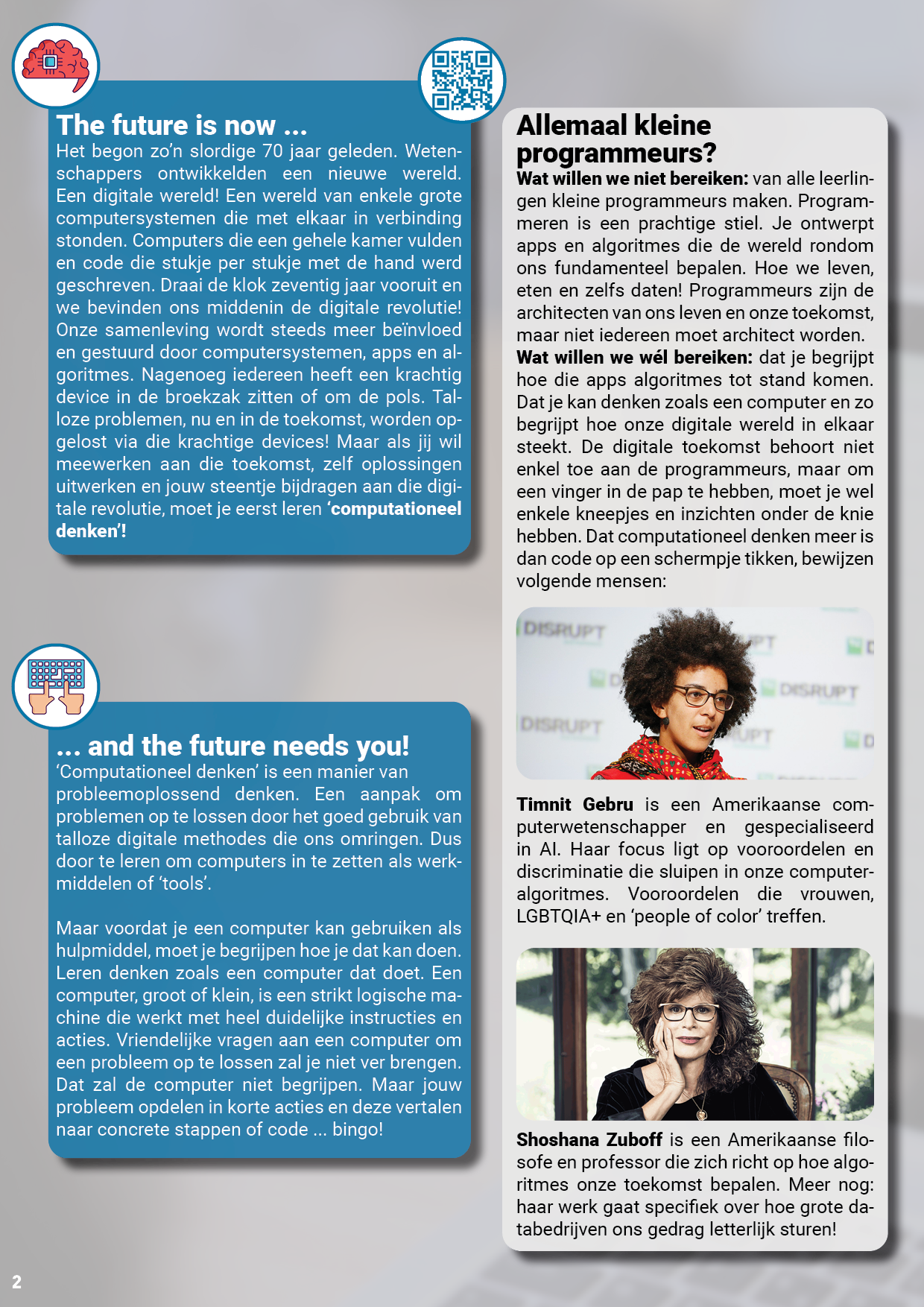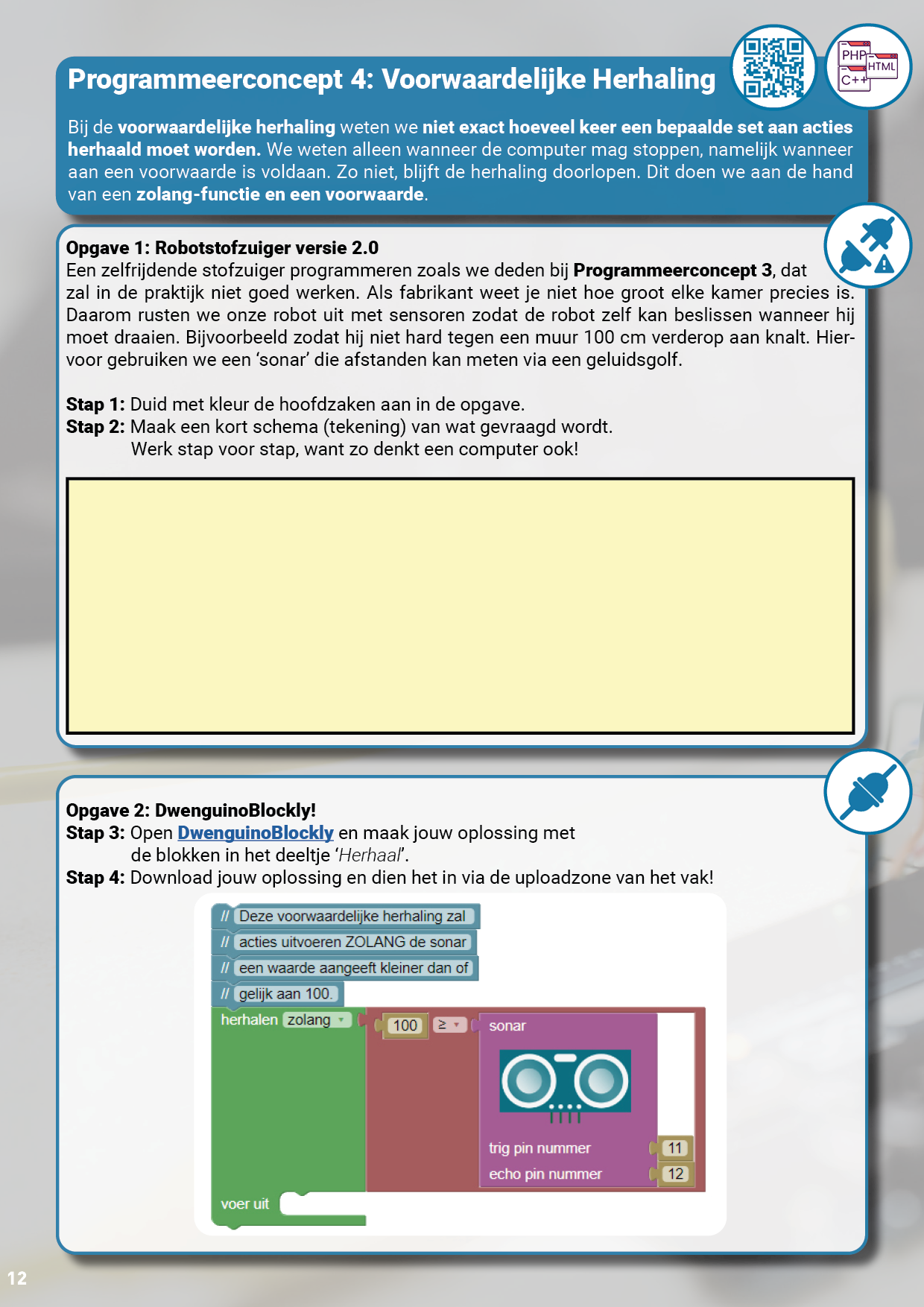Course on Computational Thinking
Why teaching ‘Computational Thinking’?
It began some 70 years ago. Scientists were developing a new world. A digital world! A world of a few large computer systems that connected to each other. Computers that filled an entire room and code that was written by hand, piece by piece. Turn the clock forward seventy years and we are in the middle of the digital revolution! Our society is increasingly influenced and controlled by computer systems, apps and algorithms. Almost everyone has a powerful device in their pocket or on their wrist. Countless problems, now and in the future, are solved via these powerful devices! But if you want to contribute to that future, work out solutions yourself and do your bit for the digital revolution, you first have to learn how to think computationally!
Computational thinking is a way of problem solving. An approach to solving problems by making good use of the countless digital methods that surround us. So by learning to use computers as work resources or 'tools'. But before you can use a computer as a tool, you need to understand how to do that. Learning to think like a computer does. A computer, big or small, is a strictly logical machine that works with very clear instructions and actions. Asking a computer politely to solve a problem will not get you far. The computer will not understand that. But breaking down your problem into short actions and translating them into concrete steps or code ... bingo!
Everybody becomes a tiny coder?
What we do not want to achieve: turning all pupils into little programmers. Programming is a wonderful craft. You design apps and algorithms that fundamentally determine the world around us. How we live, eat and even date! Programmers are the architects of our lives and our future, but not everyone has to become an architect.
What we do want to achieve: that you understand how these apps and algorithms are created. That you can think like a computer and thus understand how our digital world works. The digital future does not only belong to programmers, but to have a finger in the pie, you have to master some tricks and insights.
Goals
The material we process with these teaching materials is linked to the objectives of basic literacy in the first grade of secondary education. The Flemish Community considers these objectives extremely important to pass on to young people. So important, in fact, that everyone must achieve them. When we look at the curriculum of the Catholic Education Flanders, we find:
Basic literacy 17:
The pupil applies a given algorithm to solve a problem digitally (plugged) and non-digitally (unplugged).
Computational thinking:
Decomposition, pattern recognition, abstraction, making an algorithm, debugging (testing and adjusting) [Common curriculum ICT, LPD 3].
Teaching Materials
The teaching material was developed in the summer of 2022 based on my six years of experience as a programming teacher in secondary education and external supervisor at UGent (subject didactics B/developing teaching material). It uses both unplugged (=no computer required) and plugged (=we do use the computer) teaching activities and deals with four parts:
Why learn to think computationally;
Five steps in computational thinking;
Four programming concepts;
Evaluation.
The teaching material consists of:
a 16-page syllabus in PDF format available in print and interactive version (with hyperlinks);
a series of ten teaching videos accessible via QR codes throughout the syllabus;
accompanying PowerPoint.
During the development of the teaching material, particular attention was paid to the representation of women and people of colour. The role models used throughout the material are e.g. Ada Lovelace (first programme of the first edition of the UNESCO World Conference on Women). Ada Lovelace (first programmer), Grace Hopper (first bug report), Timnit Gebru (pioneer AI ethics) and Shoshana Zuboff (IT philosopher).
The full series of lecture videos can be found using this link (YouTube). Below, you can already find the first of no less than ten videos!
I want this in my class! What do I have to do?
Do you want to work with this in your classroom? Super! The future will be increasingly digital. A future in which artificial intelligence will play a very important role. It goes without saying that we need to prepare and motivate young people. I am happy to help you with that! Through the buttons below you can send me a message or get information about a training or workshop. I usually reply within 48 hours!







